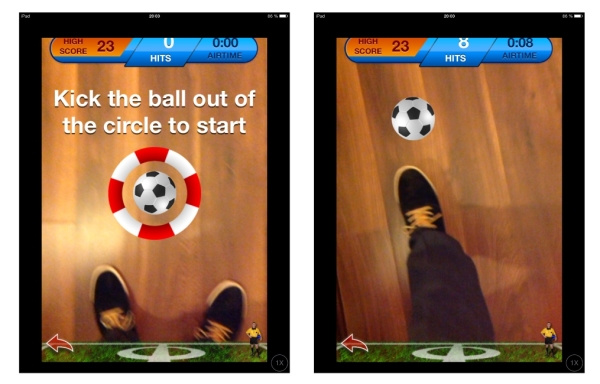Surprisingly, in most cases, a control system in AR games is not a major issue. Players move the camera over a virtual scene, so there is no need for special controls to maneuver in space. Thereby, many AR shooters only have one major button: FIRE. So, it is more interesting to know about a situation when fiducial markers are turned into tools to manipulate a game situation.
There is a difference between AR on mobile devices and some academic experiments that use optical head-mounted displays to produce AR. The latter usually needs a player to hold a gameboard with fiducial markers in his hands, tilting and moving it, since the gameboard is a way to control objects and events in a game.
A very good example is Marble Game, designed by Ohan Oda and Steve Feiner at Columbia University's Computer Graphics and User Interfaces Lab (http://www.youtube.com/watch?v=6AKgH4On65A), where players needed to guide a ball through a maze. A special game board with ARTags was used as the physical base for a virtual game scene. Its tilts were transformed into directions and the value of "the speed of the ball". Such a method cannot be applied for handheld devices, as a player cannot hold both the device and the gameboard in his hands for a long period of time. However, some tricks with movable markers can still be done: a player may hold the device with one hand and rotate it, or hold the fiducial marker in the other hand and create a game-like situation. The only issue is that the standard paradigm says that the marker is the center of a game scene, and by rotating it, you rotate the whole scene. Since the game should be oriented towards one item rather than being scene based. For instance, a model of a spherical antenna is used as an AR 3D puppet. The fiducial can be freely rotated on a tabletop by a player, which is followed by the rotation of the antenna on the screen. The main objective of such a game is to catch signals from different directions. It is worth mentioning that these signals should come from the coordinate system of the screen (view orientation) as the local coordinates of the marker are not reliable; they always change their orientation on a surface.

AR Soccer use the player's feet as an input device
A more flexible system can be constructed by using several markers. While a few of them can be used to define the coordinate system of a game scene, one marker can be used for controls. Of course, this can be more problematic in some instances, for example, if players need to print several fiducials and use them efficiently. However, this can be resolved with proper design solutions.
Potentially, markers can be placed on the movable parts of the objects (for example, wheels, legs, and so on) in order to track their motions. For example, special paper rings with fiducial prints can be put on the index and middle fingers and be introduced into the game's reality. This can either be a demonstration of augmented virtuality, where the player's fingers would play unique controls or be a part of the AR experience. This can be imagined as a funny fighting game where the fingers of two players may transform into kickboxers.
